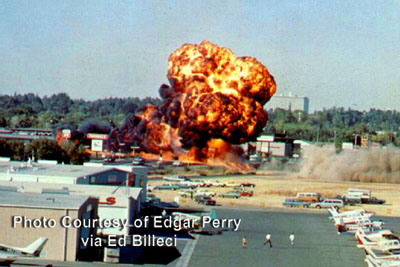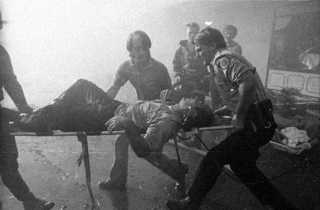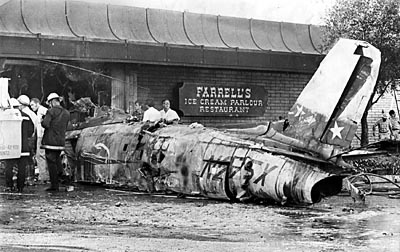Crash at Farrell's (original) (raw)
The Crash at Farrell's Ice Cream Parlor
In Sacramento, CA - September 24, 1972
Air shows have always been popular with both the old and the young alike. They are a great way of demonstrating the joy of flight to a large volume of people and, when done right, and be quite safe, even to those flying in feats of airborne wonder. On the afternoon of Sunday, September 24th, 1972, the Sacramento 49ers �Little League� football team was celebrating at Farrell's Ice Cream Parlor in the �Howard Hughes Room�, located in the Crossroads shopping center at 5770 Freeport Blvd near the Sacramento Executive Airport (SAC). That weekend, the airport had been the venue for the Golden West Sport Aviation Show, a 2-day event showcasing static and aerial exhibitions of experimental and antique aircraft.Up until 3 years earlier, the airport had been used from regularly scheduled commercial flights in and out of Sacramento until the completion of Sacramento Metropolitan Airport (SMF), 15 miles to the north. With the airport being nearly dense residential and commercial real estate, it was an ideal locale for an air show to attract from the local area. On the afternoon of Sunday, September 24th, 1972, the Sacramento 49ers �Little League� football team was celebrating at Farrell's Ice Cream Parlor in the �Howard Hughes Room�, located in the Crossroads shopping center at 5770 Freeport Blvd near the Sacramento Executive Airport (SAC). That weekend, the airport had been the venue for the Golden West Sport Aviation Show, a 2-day event showcasing static and aerial exhibitions of experimental and antique aircraft.Up until 3 years earlier, the airport had been used from regularly scheduled commercial flights in and out of Sacramento until the completion of Sacramento Metropolitan Airport (SMF), 15 miles to the north. With the airport being nearly dense residential and commercial real estate, it was an ideal locale for an air show to attract from the local area. |
|
|---|---|
_The Aircraft_In 1948, the government of Canada chose to re-equip the Royal Canadian Air Force with the F-86 Sabre fighter, the same as the United States. Canadair, a civil aircraft manufacturer in Canada at the time, was awarded a contract to produce an initial batch of ten aircraft for tool verification. However, the escalation of the Korean War changed the order to 100 aircraft. Due to difficulties in obtaining parts & equipment from the USA, Canadair slowly built up its production facility to make all parts, and equipment was obtained from Canadian suppliers.The Sabre Mark 5 was the most widely produced version of the Canadian aircraft. Outfitted with an Orenda 10 engine, it commanded 6,500 pound of thrust, carrying the craft to a maximum speed of 696 mph.This particular Sabre was manufactured on September 19th, 1954, as serial number 1054. The RCAF flown it for 300 hours, and then placed it in storage in October of 1961. It was then registered as 'N275X' in the U.S. in July of 1971, and purchased by Spectrum Air, Inc., on November 4th, 1971. It was repaired in Syracuse, NY, and flown to California in February of 1972. Sabrejet N275X - as seen one year before the crash in Sacramento Sabrejet N275X - as seen one year before the crash in Sacramento |
Sowing Seeds of Disaster... In January of 1964, the Crossroads shopping center was proposed for construction on commercially zoned property at the northwest corner of the airport on Freeport Boulevard in Sacramento. The FAA circulated particulars of the construction to various aeronautical interests in order to obtain their comments on the effect of the construction, noting that there were four obstructions the height of which exceeded the then current standards by an average of 12 feet.The California Aeronautics Commission, as well as the airport manager Don Smith, objected to the construction on the basis that it would be hazardous to the patrons of the proposed shopping center, as well as aircraft on approach to the runway. In addition, the Air Transport Association objected because it might result in a reduction of runway effective length, thereby forcing air carriers to operate at reduced capacity. The construction proposal was discussed further at an informal meeting of all concerned, and the FAA determined that the construction would not be a hazard to navigation. A few years later, in 1969, the Farrell�s Ice Cream Parlor was to be added to the shopping center, and again the airport notified those concerned of the proposal. No objections were made to this addition, that was until a month later, when the proposed sign for the parlor was determined to exceed the allowable height by over 25 feet. Once again, the FAA determined that no hazard existed because the sign had no greater adverse effect on aircraft operations, than the existing obstructions, provided it had appropriate lighting.None of this was to be a problem - until that September weekend, when the airport was home to the Golden West Sport Aviation Show. |
 A Sunday Afternoon...
A Sunday Afternoon...
With the otherwise successful wrapping up, many of the aircraft in attendance made their preparations to depart to their home airports.
After "porpoising" twice down the runway, but returning to the ground both times, the speeding fighter jet, painted in blue and gold, overran the end of runway 30, shot up over a levee, ripped through a chain-link fence, plowed across Freeport Boulevard, where it smashed through an automobile, and crashed into the Howard Hughes Room of the crowded Farrell�s Ice Cream Parlor, igniting a ball of fire.
Amateur cameramen, filming the events of the air show, caught, on celluloid, the plane's entire take-off attempt, crash, and fireball caused by the Sabrejet.
Twelve-year-old Ed Billeci was standing on the balcony of the Red Baron restaurant, which was located in the terminal building at the base of the control tower, watching the takeoff. "I knew almost instantly it would not takeoff."
 |
|---|
| Photo taken the the air traffic controller on duty at SAC tower |
Billeci recalled, "I actually started my way down the stairs from the restaurant balcony in anticipation. So when I saw the fireball erupt it startled me because I saw it before I heard the explosion. The airport alarm started. I ran, as fast as I could with my brothers from the Red Baron in the direction of the dirt parking lot. My adrenaline was pumping, I remember being so out of breath!"
"When I got to the edge of the airport property, the jet had crashed through the perimeter fence, and struck a fire hydrant which was shooting upward. I had to jump over the fence to the left of where the fire is. I couldn't go through the fence where the hole was because everything was still burning. I jumped over, now realizing it was pretty tall, and I fell, landing in the drainage canal that was full of water from the hydrant. The water went up to my knees; I was soaked."
"But I made it to Farrell's. I guess I thought I could help but it was too late. Some guys already got the pilot out, and the place was an inferno. I just stood there and watched in horror. Several cars in the parking lot of Farrell's had been knocked sideways. I could see the grille of a car in the restaurant."
The 36-year-old pilot and general manager of Spectrum Air, Richard Bingham, was helped from the wreckage by bystanders, saying "I'm sorry...I'm sorry. Get the people out!" He survived the crash with a broken arm and facial cuts after being taken to the Sacramento Medical Center.
 |
|---|
| A photo, by Leo Neibaur, of rescue workers rushing a victim away from the crash site |
The intense heat from the crash charred paint on parked automobiles 60 feet away, and the impact knocked over mannequins in the windows of nearby shops. Thick clouds of dense smoke poured out of the colorfully decorated ice cream parlor, whose employees wore straw hats and with black and white uniforms and red, white and blue garters.
"The heat was terrific. It was terribly smoky," said Sacramento Fire Chief Winston Wilson. He said the children that poured out of the parlour "looked like, all the kids you know." All of Sacramento's publicly and privately owned ambulances were called to the scene as rescue workers began dragging bodies from the flaming building, and a makeshift coroner's office was set up in the parking lot beside the building.
Moments after the crash, a 61-year-old woman and her 62-year-old husband were both struck by a truck as they attempted to cross Freeport Boulevard on foot to reach the crash site; the woman, Billie Irwin, died of her injuries.

Hundreds of people, many of whom had just been attending the air show, gathered around the shopping center - held back about 100 feet by .police lines. As the onlookers watched on, rescuers pulled debris and bodies out of the store for several hours. Burned toys, chairs and other personal effects were piled on two sides of the building
Parts of the aircraft were separated from the wreckage by investigators and hauled away. A heavy duty tow truck finally pulled the fuselage of the plane from the store, tearing a big chunk of the wall out with it. Firemen cleared debris from a crumpled auto under the plane and found the last two bodies.
The final count: Twelve children and 10 adults were killed, including the couple in the car that was struck by the jet. In addition, 28 persons were injured in the devastation. One survivor, only eight-years-old, lost nine family members in the conflagration: both parents, two brothers, a sister, two grandparents and two cousins, and one entire family of four was wiped out completely.
PostscriptThe National Transportation Safety Board concluded that the cause of the crash was that the pilot tried to lift off too quickly, in an action known as over-rotation, pointing the nose of the jet three times higher than the normal angle because he mistakenly used misleading visual cues due to a lack of experience in this type of aircraft. Instead of becoming airborne sooner, the plane never left the ground, and continued down the runway at 125 knots. Rather than eject, the pilot elected to stay with the aircraft in the fruitless struggle to gain altitude, at the risk of his own life.It was also determined that proximity of buildings, trees, and other obstacles, in conjunction with the short length of Runway 30, could have contributed to the pilot's desire to pitch-to-climb earlier and more aggressively than required. The Safety Board also noted that, if not for the air show, the pilot and aircraft would not have been at the Sacramento Airport to begin with, due to the limitations on both.Ultimately, the accident forced the closure of Runway 12-30 to jet traffic, became the impetus to a comprehensive land-use plan for the area around the airport, and resulted in a $5 million settlement for the survivors and the families of those who died, but only after years of legal maneuvers, concluding in May of 1976.The crash also highlighted an important need to the Sacramento area - a specialized burn unit. Cliff Haskell, a Fire Captain with the Sacramento Fire Department, convinced the Sacramento Area Fire Fighters Local 522, to allow him to raise funds for and establish the Firefighters Burn Institute in December of 1973. A similar facility at the University of California-Davis Medical Center was opened a month later. William Penn Patrick, the owner of the F-86 and successful entrepreneur, did not hang around for too much longer. On the morning of June 9th, 1973, he took when his P-51 Mustang out for a flight, during which he made a series of low passes, the plane entered into a steep dive, and crashed on the grounds of his High Valley Ranch. Also killed aboard the aircraft was Christian George Hagert, Penn's Managing Director from Finland. Nearly ten years after the mishap at the Sacramento airport Farrell's, in 1982, another plane, this time a Cessna Cardinal, crashed in front of the Farrell's Ice Cream Parlour in Torrance, California. William Penn Patrick, the owner of the F-86 and successful entrepreneur, did not hang around for too much longer. On the morning of June 9th, 1973, he took when his P-51 Mustang out for a flight, during which he made a series of low passes, the plane entered into a steep dive, and crashed on the grounds of his High Valley Ranch. Also killed aboard the aircraft was Christian George Hagert, Penn's Managing Director from Finland. Nearly ten years after the mishap at the Sacramento airport Farrell's, in 1982, another plane, this time a Cessna Cardinal, crashed in front of the Farrell's Ice Cream Parlour in Torrance, California. |
|---|
| We are currently searching for photos of the crash site taken during the investigation. If you have any - please contact us.Click here to see the crash site as it is today... |


